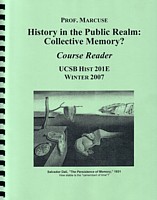I |
- Galvin, J.L., Writing Literature Reviews (Pyrezak, 1999, 49-75: Synthesizing Lit, First Draft, Coherence ..............................................................................................................
- Irwin-Zarecka, Iwona, Frames of Remembrance: The Dynamics of Collective Memory (Transaction, 1994), 193-205: annotated bibliography ....................................................
|
1
15 |
II |
- Freud, Sigmund, "Remembering, Repeating, and Working-Through" (1914), in: Std. Ed. v. 12, 145-157. (Freud 1914 pdf)
- Halbwachs, Maurice, "Individual Memory and Collective Memory," and "Historical Memory and Collective Memory," in: The Collective Memory (New York: Harper & Row, 1980), 22-49, 50-87. (pdf ch. 1; pdf ch. 2)
|
0 |
III |
- J.W. Pennebaker, D. Paez & B. Rimé (eds.), Collective Memory of Political Events: Social Psychological Perspectives (Mahwah, NJ: Erlbaum, 1997), chapters:
- Contents and Introduction, v-xi .............................................................................
- 1. Pennebaker & Banasik, "On the Creation and Maintenance of Collective Memories: History as Social Psychology, "3-20 .....................................................
- 2. Martin Conway, "The Inventory of Experience: Memory and Identity," 21-46 ..
- 7. Paez, Basabe, Gonzalez, "Social Processes and Collective Memory: A Cross-Cultural Approach to Remembering Political Events," 147-174 .............................
- 8. Gaskell & Wright, "Group Differences in Memory for a Political Event," 175-190
- 14. Baumeister and Hastings, "Distortions of Collective Memory: How Groups Flatter and Deceive Themselves," 277-294 .................................................................
|
22
26
35
48
62
69 |
IV |
- Pierre Nora, "General Introduction: Between Memory and History," in P.N. (ed.), Realms of Memory v. 1 (Columbia, 1996 [1984]), 1-20; "Introduction to volume 1," 21-23 ..............
- Pierre Nora, "The Era of Commemoration," in P.N. (ed.), Realms of Memory v. 3 (Columbia, 1998[1992]), 608-637, 702-707 ..................................................................
- Nancy Wood, "Memory's Remains: Les Lieux de mémoire," in N.W., Vectors of Memory: Legacies of Trauma in Postwar Europe (Berg, 1999), 15-38......................................
|
78
90
108 |
V |
- James Wertsch, Voices of Collective Remembering (Cambridge, 2002), 202pp.
- Jan Gross, Neighbors: the Destruction of the Jewish Community in Jedwabne, Poland (Penguin, 2002) [two monographs]
- Antony Polonski and Joanna Michlic, "Introduction," in: idem (eds.), The Neighbors Respond: The Controversy over the Jedwabne Massacre in Poland (Princeton, 2004), 1-43
|
0
0
120 |
VI |
- Harold Marcuse, "Memories of World War II and the Holocaust in Europe," in: Gordon Martel (ed.), A Companion to Europe, 1900-1945 (Oxford: Blackwell, 2006), pp. 487-503
|
142 |
VII |
- Anton Kaes, "History and Film: Public Memory in the Age of Electronic Dissemination," in: History and Memory 2:1(Fall 1990), 111-129
|
150 |
VIII |
- Karl Mannheim, "The Sociological Problem of Generations," (1927) in Paul Kecskemeti, Karl Mannheim: Essays (Routledge, 1952, 1972), 276-320 (pdf)
- Harold Marcuse, "Generational Cohorts and the Shaping of Popular Attitudes towards the Holocaust," in: Remembering for the Future (London: Palgrave: 2001), vol. 3, pp. 652-663
|
0
160
|
IX |
- Samuel Wineburg, "On the Reading of Historical Texts: Notes on the Breach between School and Academy," in AERJ 28:3(Fall 1991), 495-519 [reprinted in S.W., Historical Thinking and Other Unnatural Acts (Temple, 2001), 63-88.
|
166 |
X |
- Mark Roseman, "Surviving Memory: Truth and Inaccuracy in Holocaust Testimony," in: Robert Perks and Alistair Thomson (eds.), The Oral History Reader (Routledge, 2nd ed. 2006), 230-243
- Mary Brenner, "Interviewing in Educational Research," in: Judith Greene et al (eds.), Handbook of Complementary Methods in Education Research (AERA, 2006), 257-370.
|
178
185 |
